"The air was our element, the sky our battlefield. The majesty of the heavens, while it dwarfed us, gave us, I think, a spirit unknown to sturdier men who fought on earth. Nobility surrounded us. We moved like spirits in an airy loom, where wind and cloud and light wove day and night long the endless fabric of the changing sky...From this exalted eminence we surveyed the earth--an earth grown suddenly remote and insignificant, so vast and overpowering was the dominion of the sky."
-- Cecil Lewis, Sagittarius Rising, 1936
Canada's National Aviation Museum
 |
| Main entrance, Canada Aviation and Space MuseumOntario. Ever see a building framed by itself before? |
Rockliffe Airport is home to an incredible treasure trove of rare and unusual aircraft under roof at the Canada Aviation and Space Museum. From sole surviving artifacts of World War I to designs from Avro, Bristol, and De Havilland rarely seen in the United States, I encountered many aircraft that I did not previously know existed or had only read about.
My flight to the Canadian capital in Ottawa coincided with reading Sagittarius Rising, the 1936 memoir of WWI RAF ace Cecil Lewis who lied about his age to fly British scouts throughout the "war to end all wars". Lewis' poetically-inclined prose captures his thoughts on the development of sprightlier, sturdier aircraft throughout the conflict, describing "machines" that I had not heard of previously. These included the BE 2c, the Shorthorn, and the Sopwith Triplane (which Lewis amusingly refers to as the "Tripe"). On my visit to the Canada Aviation and Space Museum, I beheld all three for the first time and they imbued my reading with a tangible and visual connection to Lewis' harrowing tale of early airborne warfare.
To say that the Canada Aviation and Space Museum is a good museum is a gross understatement. It is one of the best I have ever visited and captures aviation history through a Canadian lens.
The Reserve Hangar
 |
| 1948 Canadair C-54GM North Star 1 ST, a derivative of the DC-4 and the sole surviving example of its type. |
Before exploring the main museum, I joined the 11:30 tour of the Reserve Hangar. This is where the museum stores aircraft in various states of restoration that are not displayed in the main building. Because it is effectively an overflow facility, aircraft are packed tightly together and sight lines are not ideal for photography. That did not stop many of us on the tour from capturing pictures anyway.
The Reserve Hangar is so large that it easily swallowed this DC-9 airliner in Air Canada livery. When the DC-9 landed on Rockliffe's 3,319 foot long runway, it was lightly loaded with minimum fuel to manage its momentum. The pilots successfully stopped it in an incredible 1,900 feet (per the docent), but destroyed the tires and burned the brakes in the process.
 |
| 1944 De Havilland Mosquito. |
 |
| 1944 De Havilland Mosquito. |
A rare treasure on display is this 1944 vintage De Havilland Mosquito, the all-wood, dual Rolls-Royce Merlyn powered fighter-bomber of World War II. This particular example was manufactured in Canada.
 |
| 1942 Bristol Bolingbroke. |
This Bristol Bolingbroke was built under license by Fairchild in Canada and used as a coastal patrol ship as well as a bombing and gunnery trainer by the Royal Canadian Air Force (RCAF). It was the first of many examples of aircraft that I did not previously know existed.
 |
| Sopwith Triplane, homebuilt reproduction (Carl Swanson, USA). |
 |
Sopwith Triplane, homebuilt reproduction (Carl Swanson, USA).
|
Until reading Sagittarius Rising, I was completely unaware that Sopwith ever produced a triplane. This version is an authentic reproduction built in the United States. Its short wings gave it a favorable roll rate and its introduction inspired Fokker to mimic the design with the Dr.I to notoriously devastating effect. Only 147 Sopwith Triplanes were manufactured starting in 1916. By mid 1917, the Triplane was displaced by the famous Sopwith Camel. Cecil Lewis was very enamored with the "Tripe".
"Of all machines, the Triplane remains in my memory as the best -- for the actual pleasure of flying -- that I ever took up. It was so beautifully balanced, so well-mannered, so feather-light on the stick, and so comfortable and warm. It had what was then a novel feature, an adjustable tail plane to trim the machine fore and aft. Set correctly, with the throttle about three-quarters open, the Tripe would loop, hands off, indefinitely. Not for this, but for its docility, the lack of all effort needed to fly it, and yet its instantaneous response to the lightest touch, it remains my favourite. Other machines were faster, stronger, had better climb or vision; but none was so friendly as the Tripe." (Cecil Lewis, Sagittarius Rising, 1936.)
 |
| 1915 Royal Aircraft Factory BE 2c. |
Next, I came across a truly ungainly looking biplane. The spacing between wings seemed cartoonishly large versus the size of the fuselage. If our docent identified it for the group, I was out of earshot. I was moved to photograph it only because I was struck by how gangly it was.
 |
| 1915 Royal Aircraft Factory BE 2c. |
|
A careful review of the museum's website after the fact revealed the mystery aircraft's identity. It is a 1915 Royal Aircraft Factory BE 2c. It was designed by Geoffrey De Havilland before he went on to design much better aircraft for his own company. I already had a strong opinion of this biplane based on Cecil Lewis' writing.
"If there was ever an aeroplane unsuited for active service, it was the BE 2c." (Cecil Lewis, Sagittarius Rising, 1936.)
Though a successful WWI era trainer, the BE 2c biplanes used for battlefield observation were no match for newer German aircraft, thus earning them the nickname "Fokker Fodder".
 |
| Royal Aircraft Factory S.E.5a. |
 |
| Royal Aircraft Factory S.E.5a. |
"Just before my nineteenth birthday I was posted to London Colney to join No. 56 Squadron, which was then forming to go overseas. The squadron was to be equipped with the SE 5, the last word in fighting-scouts, turned out by the Royal Aircraft Factory. It was fitted with a 140-h.p. Hispano Suiza engine and two guns: one Vickers, synchronized, and firing through the propeller by means of the new Constantinesco gear; and one Lewis gun, clamped on to the top plane and firing over the propeller... The machine (for 1917) was quite fast. It would do about a hundred and twenty on the level and climb ten thousand feet in twelve minutes. It could be looped and rolled and dived vertically without breaking up. Altogether it was a first-class fighting-scout (probably the most successful designed during the war), and was relied upon to re-establish the Allied air supremacy lost during the winter." (Cecil Lewis, Sagittarius Rising, 1936.)
 |
| University of Toronto "Great Flapper" Ornithopter. |
This curious bird represents the world's only "successful" piloted, powered (by an engine) ornithopter. In other words, it flew by flapping its wings like a bird. Fittingly, it is known as the Great Flapper. I was the only one in the tour group who knew what an ornithorpter was, but that was only because I read Dune as an eighth grader.
 |
| The University of Toronto Institute for Aerospace Studies Great Flapper ornithopter during trials, Malton, Ontario, 2005. http://www/ornithopter.net |
The project was led by Michigan-born James Duncan DeLaurier while he was at the University of Toronto Institute for Aerospace Studies. After many years of effort, the
Great Flapper flew a distance of 1,000 feet at an altitude of 3 feet on 08 July 2006. The flight, lasting 17 seconds, is considered the longest achieved by a piloted, powered, ornithopter. Video of the flight is available
here and it looks every bit as ungainly as might be expected.
 |
1918 Avro 504K.
|
From 1920 to 1928, the Avro 504K was the standard trainer for the Royal Canadian Air Force. This specific 1918 Avro 504K biplane was obtained from
Cole Palen at Old Rhinebeck Aerodrome. It was part of the original collection of WWI era aircraft that Palen acquired on Long Island, NY to seed the Old Rhinebeck Aerodrome fleet.
 |
| 1918 Avro 504K fitted with the Turnbull variable pitch propeller. |
What makes this particular Avro 504K special is that it was the first aircraft ever equipped with a variable pitch propeller. Patented in 1922, this installation of Wallace Rupert Turnbull's electric variable pitch propeller was first successfully demonstrated at Camp Borden in Ontario, Canada during June of 1927. In 1929, Turnbull sold the patent to the newly formed Curtiss-Wright aeronautical conglomerate. During World War II, Curtiss-Wright produced nearly 150,000 variable pitch propellers
 |
| A 1942 Curtiss Kittyhawk originally issued to the 132 Squadron based in Rockliffe. |
 |
| A 1945 North American P-51D acquired by the RCAF and stationed near Vancouver, British Columbia. |
 |
| 1952 North American Harvard. |
Canadian variants of the highly successful T-6 Texan advanced trainer of WWII were known as Harvards. Harvards can be distinguished from their American counterparts by the shroud surrounding an elongated exhaust pipe. This heat shroud was used for cabin heating, a feature absent from the original T-6, but quite necessary in Canada.
Umm...
(Pulls out tape measure. Slowly backs away.)
It is always good to see a sense of humor in play.
 |
| 1945 Bristol Beaufighter T.F.X. |
This collection of parts will someday result in fully restored Bristol Beaufighter, considered the first effective radar-equipped night fighter. The Beaufighter was flown by the US Army Air Corps during WWII prior to the introduction of American designs like the
P-61 Black Widow. This is one of only eight known surviving Beaufighters worldwide. The example at the
National Museum of the United States Air Force in Dayton, OH is the only one of its kind in the United States.
 |
| 1953 McDonnell F2H-3 Banshee. |
 |
| 1948 Hawker Sea Fury FB.11. |
Considered one of the fastest piston-driven fighters ever built, the Hawker Sea Fury was the last fighter with a reciprocating engine used by the Royal Navy.
 |
| Panoramic of the massive Reserve Hangar at the Canada Aviation and Space Museum. |
Concluding the one hour Reserve Hangar tour, our docent invited "the photographers" (she looked specifically at me and two others) to take in the view from the mezzanine. Between multiple airliners, a C-130 Hercules, a B-25 Michell, a Consolidated PBY Catalina, a Consolidated B-24 Liberator, and many other aircraft, I was astounded by how much history was crammed within the walls of the Reserve Hangar.
Main Building
The Canada Aviation and Space Museum main lobby barely accommodates a Canadair CT-114 Tutor frozen in time mid-roll. A side-by-side military trainer in use from 1963 to 2000, the Tutor is best recognized outside of Canada as the platform of the Canadian Forces Snowbirds, a jet aerobatic demonstration team.
 |
| A panoramic view of the Canada Aviation and Space Museum from the front. |
 |
| Reproduction of the A.E.A. Silver Dart, the first powered, controllable aircraft to fly in Canada in 1909. |
Prominently displayed at the entrance to the main gallery, this 1959 reproduction of the A.E.A. Silver Dart represents the first powered, controllable flight in Canada accomplished by Canadian J.A.D. McCurdy over Baddeck Bay, Nova Scotia on February 23, 1909. McCurdy was a member of Alexander Graham Bell's Aerial Experiment Association (A.E.A.) that included Glenn Curtiss among its ranks. The lines of the Silver Dart are very reminiscent of the June Bug flown by Curtiss on 04 July 1908 during the first pre-announced heavier than air flight in the United States. (The "pre-announced" distinction was a not-so-subtle dig at the secretive Wright Brothers.) Though designed by McCurdy, the Silver Dart is obviously derived from Curtiss' June Bug and was manufactured in Curtiss' hometown of Hammondsport, NY. This replica was constructed by RCAF members and successfully flown on the 50th anniversary of the original Baddeck Bay flight.
 |
| Sole-surviving example of a 1911 Borel-Morane. |
This is the sole-surviving example of a 1911 Borel-Morane. Built as a joint venture between Gabriel and Albert Borel, Leon Morane, and Raymond Saulnier, this single seat monoplane resembled the famous Bleriot XI, but represented an advancement of the design that was lighter and faster. (Saulnier actually worked with Louis Bleriot to develop the XI.)
Morane-Saulnier would go on to produce several World War I era aircraft, some of which can be found at
Old Rhinebeck Aerodrome (an "N" and an "AI"). The Morane-Saulnier L, colloquially known as the "Parasol" was featured prominently in
Sagittarius Rising.
"I had a look over her, and the more I saw of her the less I liked her. It was certainly not love at first sight...the elevator was as sensitive as a gold balance; the least movement stood you on your head or on your tail. You couldn't leave the machine to its own devices for a moment...the Morane really was a death trap...Subsequently I flew every machine used by the Air Force during the war. They were all child's play after the Morane...but I did come to love the Morane as I loved no other aeroplane." (Cecil Lewis, Sagittarius Rising, 1936.)
 |
| 1915 McDowall monoplane. |
This artifact is considered the oldest surviving Canadian aircraft, though that might be something of a stretch as the monoplane never actually flew beyond making a few hops. It was constructed by Robert McDowall from Ontario and is similar to (if less successful than) the Bleriot XI design that he would have witnessed while traveling in Europe.
 |
| 1916 Maurice Farman S.11 "Shorthorn". |
 |
| 1916 Maurice Farman S.11 "Shorhorn". |
This cumbersome looking aircraft is a 1916 Maurice Farman S.11 that was nicknamed the "Shorthorn". Outmatched militarily early in the war, it was frequently relegated to a trainer role. This one is the only example of its type in North America and appears to be one of only three survivors worldwide.
"I took my ticket (i.e. learned to fly and obtained my pilot's certificate) on a Maurice Farman 'Longhorn'...If you crashed it, there was such a lot between you and the ground that you were unlikely to get seriously hurt. Also it had no vices. It was docile and well-behaved...The Longhorn (of beloved memory) had a sister, the 'Shorthorn'. This had dispensed with the skids and elevator forward, and had a somewhat more workmanlike appearance...Pupils were only allowed to fly the Shorthorn after taking their tickets. We used to 'put in time' on them." (Cecil Lewis, Sagittarius Rising, 1936.)
 |
| 1918 Curtiss Canuck. |
At first glance, this aircraft appears to be a Curtiss JN-4D ("Jenny"). It is, in fact, a Canadian variant known as the Canuck. The model is credited as the first aircraft to cross the Canadian Rockies, the first mass-produced aircraft in Canada (as fabricated by Canadian Aeroplanes Ltd in Toronto), and first to deliver air mail in Canada (Montreal to Toronto, 24 June 1918).
This particular example was manufactured in Toronto. It spent over thirty years hanging in a barn in Honeoye Falls, NY (just south of my home in Rochester) before it was acquired by the museum.
 |
| 1918 Sopwith 2F.1 Ship Camel. |
 |
| 1918 Sopwith 2F.1 Ship Camel. |
This rotary-engine biplane is a naval derivative of the famous Sopwith Camel, one of the most successful British fighters of World War I.
 |
| 1918 Sopwith 7F.1 Snipe, the successor to the Sopwith Camel. |
The Sopwith Snipe was considered the most advanced rotary-engine British fighter. It was only slightly faster and nearly as maneuverable as the Camel, but less of a handful to fly. Only two original Sopwith Snipes exist in the world today, this one in Ottawa and another on display at the Smithsonian National Air & Space Museum (that previously came from Cole Palen's collection at Old Rhinebeck Aerodrome).
 |
| 1918 Fokker D.VII. |
When it was introduced in 1917, the Fokker D.VII became the most feared aircraft in the skies over war-torn Europe. It so distressed Allied pilots that the 1918 Armistice specifically required Germany to surrender all examples of the D.VII. This is one of only two that exist in Canada.
 |
| 1918 A.E.G. G.IV. |
 |
1918 A.E.G. G.IV.
|
A.E.G. was a German company that built aircraft between 1912 and 1919. The G.IV (where "G" stands for Grossflugzeug or "large airplane") was introduced in 1917. Often painted in dark colors, it was used as a night bomber during WWI. This is not only the sole surviving example of a G.IV, it is the only surviving multiengine German aircraft from WWI. It was taken by the Allies as a war trophy. Though currently displayed without engines, pictures of this airplane exist to demonstrate that the museum is in possession of them.
 |
| 1918 Junkers J.I. |
In an era where most aircraft had wood-frames and fabric skins, the Junkers J.I had a metal structure with the forward portions of the airframe skinned in steel plate. The aircraft was incredibly strong and excelled at low altitude observation because it was armored to resist ground fire.
 |
| 1918 Junkers J.I. |
The Canada Aviation and Space Museum's Junkers J.I is the sole surviving example of its kind. It was sent to Canada from France as a war trophy in 1919 and remains on display in an unrestored state.
 |
| Fairey Swordfish (year of manufacture unknown). |
Despite an antiquated design for the era, carrier-based Fairey Swordfish biplanes were in service between 1936 and 1944 as torpedo bombers. In 1941, the type participated in the famous sinking of the German battleship Bismarck. Note the folding wings for easier storage on aircraft carriers.
 |
| 1967 Westland Lysander. |
Lysanders were used for observation and coastal patrol during WWII. This particular example was built by the RCAF in 1967 from components of three other Lysanders to celebrate Canada's centennial.
 |
| 1945 Avro Lancaster Mk.X. |
A massive Avro Lancaster heavy bomber dominates the World War II section of the museum. The British answer to the American B-17 Flying Fortress and B-24 Liberator bombers, it was considered one of the most successful night bombers of WWII due to its massive weapons bay. The bomber was equipped with four Rolls-Royce V-12 Merlyn engines that also powered American Mustangs and British Spitfires. Thus, I like to think of the Lancaster as representing four Spitfires flying in very close formation.
 |
| 1945 Avro Lancaster Mk.X. |
Post war, "Lancs" were used for maritime patrol, photo survey, and search and rescue.
 |
| 1945 Avro Lancaster Mk.X. |
Today, there are 17 surviving Lancasters. The Canada Aviation and Space Museum's Lanc is considered the most complete example of a Mk.X model.
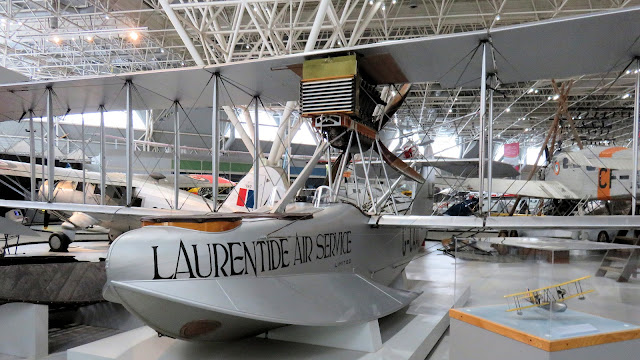 |
1918 Curtiss Curtiss HS-2L.
|
A flying boat design is a natural from the man considered the father of Naval aviation in the United States, Glenn Curtiss. Curtiss designed these flying boats for coastal patrol during WWI. Post-war, the HS-2Ls became Canada's first bush planes and dominated this mode of flying until circa 1927. This is the only complete HS-2L remaining in the world.
 |
| 1918 Curtiss Curtiss HS-2L. |
This HS-2L is the product of a sixteen year restoration effort. Its markings are in tribute to La Vigilance, a Curtiss ship of the same design that was the first purchased by Laurentide Air Service Limited, the world’s first bush flying company. The original La Vigilance crashed on 02 September 1922 into Foss Lake, Ontario. The original hull was salvaged around 1969 and is now displayed alongside the museum's HS-2L.
 |
| 1943 Noorduyn Norseman VI. |
Designed in 1935 by Canadian Robert Noorduyn, the Norseman was the first purpose-built bush airplane in Canada. Nicknamed the "one-ton flying truck", it was the first Canadian aircraft to be adopted for use by the US military during WWII. As suggested by the beefy landing gear, the airplane excelled at operating from rough terrain.
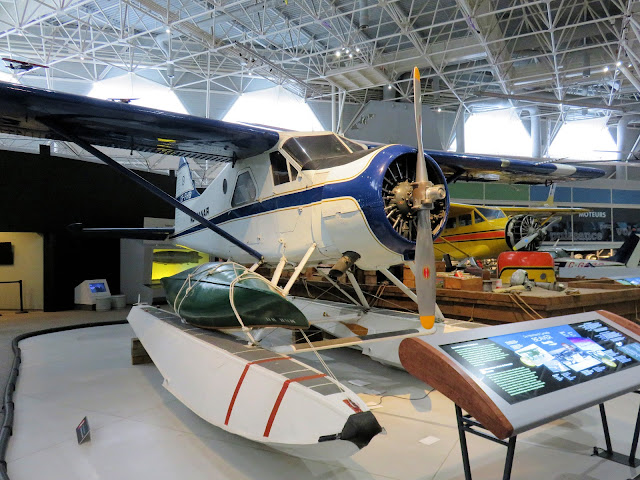 |
| 1947 prototype De Havilland Canada DHC-2 Beaver. |
1940s vintage De Havilland Beavers were the first all-metal bush planes designed and built in Canada. The most prolifically-manufactured aircraft in Canada, these aircraft were so rugged and reliable that they remain workhorses today.
On our last trip to Alaska, we saw Beavers everywhere. The displayed Beaver is not just representative of the model, it was the first ever produced.
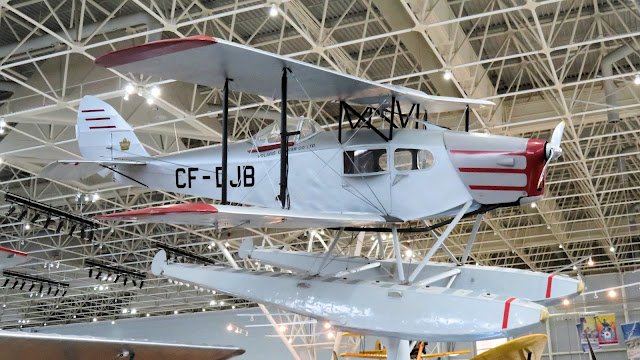 |
| 1947 De Havilland Fox Moth. |
The De Havilland Fox Moth was a 1931 design developed for use as a civil air taxi. It used the engine and wings of the classic De Havilland Tiger Moth military trainer. With military contracts cancelled at the end of World War II, Fox Moth manufacture kept De Havilland's Canadian factory running while consuming surplus Tiger Moth components and supplying Canada's burgeoning need for bush planes.
 |
| 1931 Junkers W 34. |
 |
1931 Junkers W 34.
|
If it has a corrugated skin and it's not a Ford Trimotor, it must be a Junkers design! This 1931 Junkers W 34 was flown by Canadian Airways, Canada's largest bush plane operator of the era. Originally providing a lifeline to mining facilities in northern Quebec, it also flew in western Canada. In 1962, the airplane was purchased by Muriel Richardson and donated to the museum in honor of James Richardson, her late husband and founder of Canadian Airways.
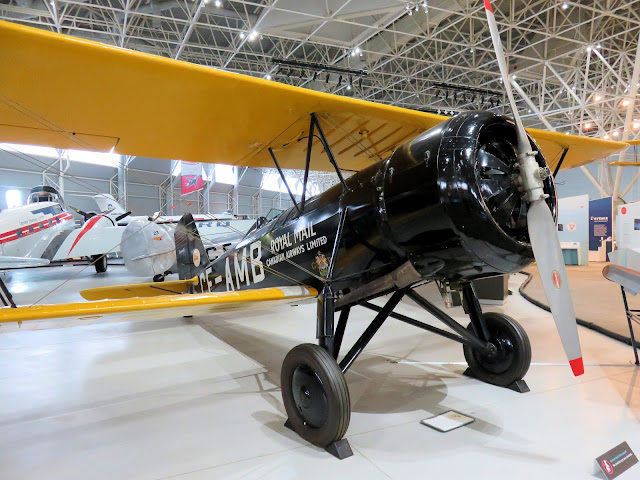 |
| 1930 Stearman Speedmail. |
I first laid eyes on a Stearman Speedmail in 2003 at the
National Air Tour stop in Kalamazoo, MI. Painted in a striking yellow and black color scheme, I thought it was the coolest looking biplane I had ever laid eyes on. Apparently, its creator, Lloyd Stearman and I are in violent agreement; he considered it his best design. Four Speedmails carried mail for Canadian Airways until the mid 1930s when airlines began using aircraft capable of carrying both mail and passengers at the same time.
 |
| Name plate from a Curtiss Conqueror V-1570 liquid cooled aircraft engine. |
 |
| 1937 Lockheed L-10A Electra. |
Perhaps best known as the aircraft in which Amelia Earhart and Fred Noonan disappeared during an attempt to circumnavigate the globe, the Electra was popular with small airlines. This specific aircraft was the first new airplane ever purchased by Trans-Canada Air Lines (the predecessor to Air Canada) and bears their livery. It also served the RCAF as a transport during WWII and was flown by American Ann Pellegreno on a 1967 earthrounding flight recreating the route planned by Amelia Earhart.
 |
| 1944 Supermarine Spitfire, one of the most successful fighter aircraft of WWII. |
 |
| 1942 Hawker Hurricane produced by Canadian Car and Foundry, Fort William (Thunder Bay), Ontario. |
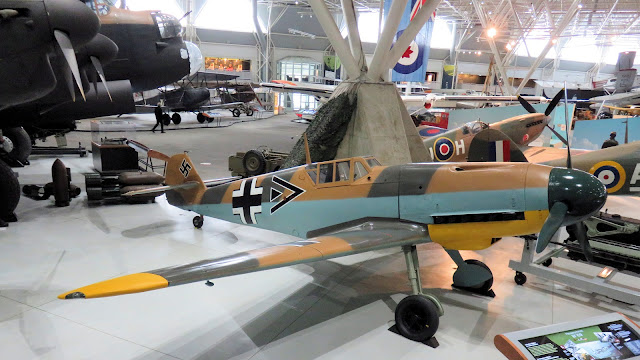 |
| 1942 Messerschmitt Bf-109. |
Considered one of the best fighter aircraft of WWII, the Messerschmitt Bf-109 was produced in numbers exceeding 33,000 between 1935 and 1956, making it one of the most numerous fighter types ever built.
 |
| 1945 Heinkel He 162 Volksjager. |
Designed in only 90 days in the final, desperate days of World War II, Heinkel's jet propelled Volksjager ("People's Fighter") was intended to be inexpensive and simple to build (particularly by unskilled, mostly forced, laborers). To avoid unpleasant ingestion of the pilot by the engine during bailout, the Volksjager was the first single engine aircraft to incorporate an ejection seat. This example was captured in Leck, Germany and exhibited in London as a war trophy before being sent to Canada in 1946.
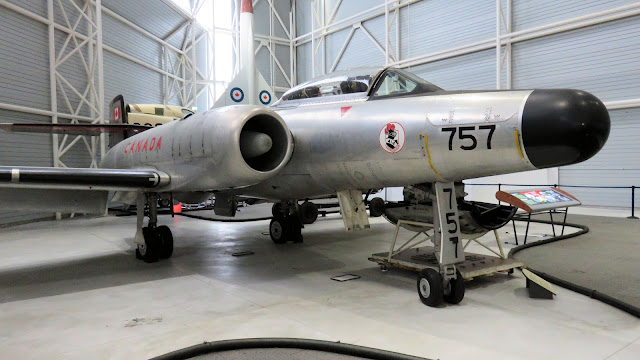 |
| 1958 Avro Canada CF-100. |
Particularly in the jet age, the Canadian military has flown a large number of other nation's aircraft including designs from England and the United States. The CF-100 is one of the few examples of a purely Canadian design that went into service in 1952. Radar equipped, the CF-100 was considered one of the best all-weather fighters of its day.
 |
| 1957 Lockheed F-104 Starfighter. |
 |
| 1957 Lockheed F-104 Starfighter. |
|
Lockheed's famous Mach 2 interceptor, "the missile with a man in it", served the RCAF in addition to the United States Air Force. Wing Commander Robert A. White set Canada's current altitude record of 100,110 feet in this very aircraft on 14 December 1967.
As in the United States, Canadian WWII military trainer aircraft were painted yellow for high visibility. Front and center in frame is another example of the Harvard advanced trainer.
 |
| 1945 Avro Anson V. |
Originally designed as a small passenger aircraft, the all-wood Avro Anson was used for coastal patrol and as a multi-engine and bomber trainer. So reliable, it was nicknamed "Faithful Annie".
 |
| 1941 De Havilland Menasco Moth |
Much as the Stearman taught many American airmen to fly during WWII, the Tiger Moth served that function for British and Canadian military pilots. Fears that German blockades would limit availability of British powerplants for these aircraft, De Havilland Canada re-engineered the Tiger Moth to accommodate an American Menasco engine. In contrast to the 1,425 Tiger Moths built in Canada during WWII, only 125 Menasco Moths were constructed. This example is believed to be the only surviving example of an original Menasco Moth.
It is important to note that the Canada Aviation and Space Museum is not merely backward looking. As an institution, the museum stands ready to accommodate the aviators of the future as well. An impressive kid-friendly training fleet stands ready in the middle of the museum.
The preceding is just a sampling of the impressive collection housed by the Canada Aviation and Space Museum. There is much to see here. I spent three hours at the museum learning about new (to me) aircraft and making physical contact with artifacts that put Cecil Lewis' WWI memoir into greater visual context. A small onsite cafe satisfactorily accommodated my lunchtime needs. For the extent of the collection and the rare artifacts on display, the Canada Aviation and Space Museum is undeniably world class and well worth the visit.

































































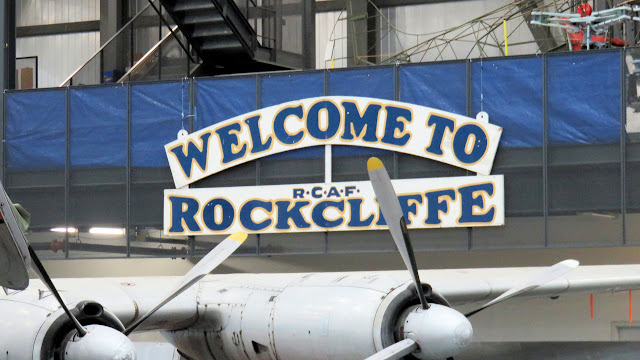




Thanks for sharing! Great pics as always.
ReplyDeleteI am surprised there is not one de Havilland Canada DHC-4 Caribou.
ReplyDeleteThat's funny. They have examples of a DHC-2 (Beaver), DHC-3 (Otter), DHC-5A (Buffalo), DHC-6 (Twin Otter), and DHC-7 (Dash 7), but no DHC-4 Caribou. Seems like a miss from a completist point of view, doesn't it? :-)
Delete